The title of this article might be a misnomer, since spey fishing, a minor segment of the fly fishing industry, has grown with lots of equipment options, specialties and styles, but also because of the never-ending supply of suggestions and opinions about the sport. This article is just that — some of my opinions to help those of you who are either newbies or novices to two-handed casting/fishing. Hopefully these suggestions will make the experience not only easier to get started, but less confusing and intimidating.
Brief History
Spey fishing was originally developed in Scotland on the River Spey where long casts were required but little room for a back cast existed. Long rods were employed and a unique style of casting developed that allowed long casts with short back casts. Today, this method – spey casting – is commonly referred to as two-handed casting. The predominate presentation used with this method has typically been a wet fly swing – casting at a downstream angle and letting the fly “swim” across the river as the current brings it to the downstream position below the angler.
The advantages of using these longer rods and “organized” roll casts goes beyond making long casts with short back casts – they include: requiring a minimal effort to cast long distance, excellent line control, leverage to cast large flies with heavy sink-tips, and overall efficiency.
Today
Within the last 30 years, North American anglers adopted this technique and originally applied it to steelhead and salmon fishing, the most common species targeted with two-handed rods. Most places where flies are presented on the swing for just about any species (trout, smallmouth bass) are applicable for two-handed casting/fishing – using these rods just makes it easier and efficient once learned. The original “spey” flies with their slim profile and often wispy materials are still available today and remain effective, however they have been combined with various streamer designs, tying materials and techniques offering a great selection of fly patterns to choose from for a number of species.
Considerations & Suggestions for Learning Two-Handed Casting
Avoid Intimidation. There is a lot of equipment out there, lots of jargon, shop slang and other terms that might seem confusing, overwhelming and even contradictory – it is easy to step back and question whether or not to try two-handed casting but it’s like many things that are new to us. Remember the first time you used a computer? Choose one or two sources of information that you trust to get started and consult those sources with questions you have about the sport. These sources could be an experienced friend or a fly shop with an understanding and experienced staff you trust.
Choose a Casting Style. This is where your trust in the sources mentioned above can first help. There are a number of different casting styles with two-handed casting/fishing – Classic, Skagit, and Scandinavian are the most common. Each style offers pros and cons. The species you intend to target, the rivers you are most likely to fish, and the flies you will use should help make this decision easier.
Learn that Style. Now that you have picked a style, learn it. Too often I have seen anglers bounce from one style to another without having a solid grasp of either method. The long, fluid motions often used with the longer lines of Classic does not lend itself to Skagit style, nor does the abrupt bottom-hand casting of Scandinavian casting work well the other two styles. Stick with one style and become proficient with it before experimenting with other styles.
Practice. You probably don’t get a chance to fish enough, so the few times you can hit your favorite river when conditions are ideal is no time to learn how to cast a two-handed rod – it’s the time to fish. Spending time in the off-season on rivers, lakes or even the lawn can assist in learning and provide the muscle memory, ability and efficiency required to take advantage of two-handed casting/fishing. Keep in mind that while floating lines are typically used when learning, as they are more forgiving with bad technique, they don’t cast the same as a sink tip. If you intend on fishing with sink-tip lines, begin practicing with that line setup once you can execute the fundamentals of casting with a floating line.
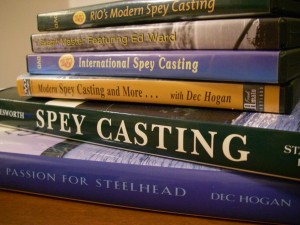 Practice Makes Permanent. Make sure that you are practicing the right thing, not reinforcing the poor technique. There are lots of resources to help you learn the fundamentals of casting, including DVDs, books and instructors. Find what works best for you and once you know what you are supposed to do, practice and learn the right things, not the wrong. I personally found a combination of all three resources worked well for me, and as I continue to advance with my technique, I often consult the same resources.
Practice Makes Permanent. Make sure that you are practicing the right thing, not reinforcing the poor technique. There are lots of resources to help you learn the fundamentals of casting, including DVDs, books and instructors. Find what works best for you and once you know what you are supposed to do, practice and learn the right things, not the wrong. I personally found a combination of all three resources worked well for me, and as I continue to advance with my technique, I often consult the same resources.
Learn the Same Length. When initially learning to cast, determine what amount of line is ideal to load the rod while offering you control of the line through the cast. Each time you will find that casting the same amount of line will be much easier to control vs. a varying length thanks to the muscle memory you have developed by repetitively making the same motion with a fixed amount of line. Once determined, make it easy to identify the right amount of line by marking your line at your hand with a permanent marker. Should you choose to shoot the line on the forward delivery, go for it – this step takes place after the crucial line placement, but remember it’s easier to learn to walk before running.
Two-Handed Rods vs. Switch Rods. A two-handed rod is designed to be cast with two hands for specific applications and presentations. A “switch rod” is a rod that allows you to fish it with one hand or two; one hand while doing conventional overhead fly casting or you can “switch” and use two-handed methods. Both rods require two hands to cast, but the switch rod is no replacement for a two-handed rod. With that being said, there are applications for a switch rod that make them a better choice over two-handed rods. Two-handed rods often require a significant amount of the line to help load the rod to cast. If fishing smaller rivers or making smaller casts, the longer, two-handed rod isn’t necessarily the best choice whereas the switch rod often lends itself to smaller bodies of water and shorter casts. Further, two-handed rods typically cast longer distances, heavier flies and longer sink-tip sections.
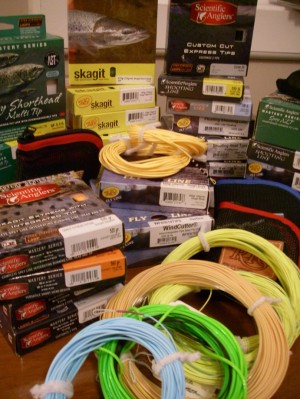 Find a Line, Then Buy It. This can be the one of the more difficult, confusing, timely and often expensive aspects of learning to use a two-handed rod. Single-hand rods have a line weight designated for each rod – that is a 6 wt. rod casts a 6 wt. line. While there can be a few exceptions, it generally holds true. With two-handed rods the line weight printed on the rod is not a determining factor for which weight to use.
Find a Line, Then Buy It. This can be the one of the more difficult, confusing, timely and often expensive aspects of learning to use a two-handed rod. Single-hand rods have a line weight designated for each rod – that is a 6 wt. rod casts a 6 wt. line. While there can be a few exceptions, it generally holds true. With two-handed rods the line weight printed on the rod is not a determining factor for which weight to use.
Two-handed lines are much heavier than their brethren. An 8 wt. line for a single-handed rod will not work on an 8 wt. two-handed rod. Two-handed rods often have a “grain-window” meaning it will cast a number of different line sizes (measured in grains) that load the rod. Each person has a preference for how the rod feels and the best performing line size. Fly size, style and amount of sink-tip are all factors in narrowing down which line is best for your rod. Confusing, I know.
Buying a line, trying it and finding out it isn’t what you hoped can be expensive – especially after a number of attempts. You can ask what others like on your rod, but that’s what they like and there are typically variances in everyone’s opinion. But asking can help establish a starting point. Fly shops dedicated to spey fishing often have a demo kit consisting of a number of fly lines for you try on your rod before you buy the line. Think: “Test Drive.” Another way is to try lines that your friends own. Once you have identified which line is best for you, buy it with confidence.
 Learn Four Casts. As technique, equipment and styles for two-handed rods developed, so have casts. Still, there are some basics I think one should learn which will prove effective under most situations: Single Spey, Double Spey, Snake Roll and Snap-T/Circle Spey. Because wind direction varies as does our position in river, it suggested that you learn to make all four casts with your left and right hand on the top fore grip to keep your back cast downwind of us – with gusts of wind, and sharp hooks the ability to make your casts safely is just good thinking.
Learn Four Casts. As technique, equipment and styles for two-handed rods developed, so have casts. Still, there are some basics I think one should learn which will prove effective under most situations: Single Spey, Double Spey, Snake Roll and Snap-T/Circle Spey. Because wind direction varies as does our position in river, it suggested that you learn to make all four casts with your left and right hand on the top fore grip to keep your back cast downwind of us – with gusts of wind, and sharp hooks the ability to make your casts safely is just good thinking.
Speyclave. Two-handed anglers are often dedicated members of the fishing community who not only like to fish, but choose to do it in a particular manner. As such, they tend to communicate their lingo, jargon, share their experiences and what seems to be never ending supply of opinions – some good, some not necessarily so. One format for this sharing is through Speyclaves – one or two-day events which are organized near a river with manufacturer representatives, guest speakers/instructors, and anglers like you. These are great venues to learn more about the sport, techniques, and demo/try lines and rods – check out for more information about a Speyclave happening near you at www.speypages.com/speyclave.
Confused?
Go back to the first suggestion which is to have a resource or two who you can consult with. Most people find it’s worth learning to cast and fish a two-handed rod as it’s similar to learning how to fly fish all over again, bringing with it the excitement we once had when we first picked up that single-hand rod. Remember, when it is all said and done, all we are trying to do is feed a fly to a fish. In this case, we are using a rod that requires two hands to cast it. Simple, isn’t it? At least in concept. Good luck and have fun.

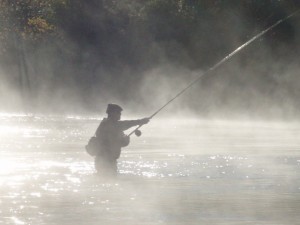
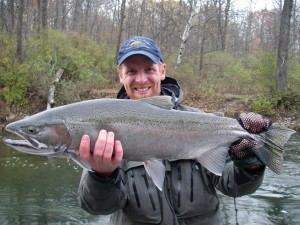

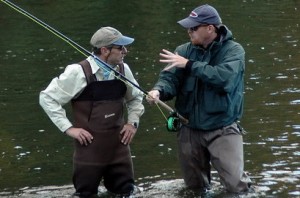
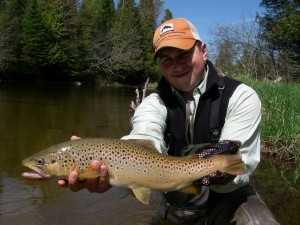
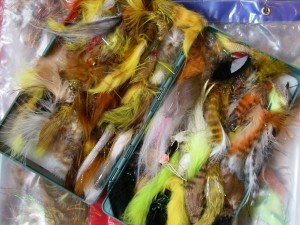
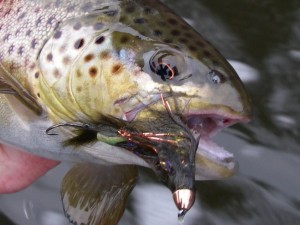
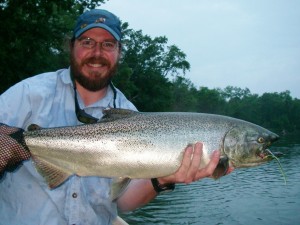
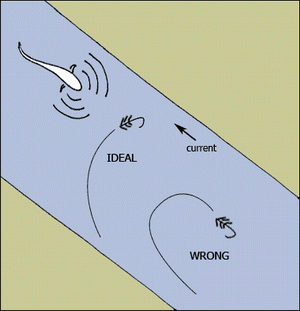

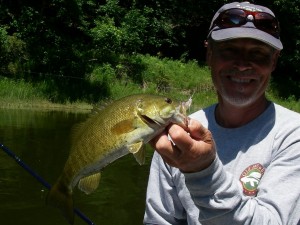

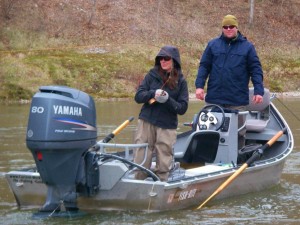
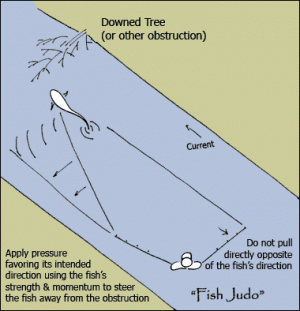
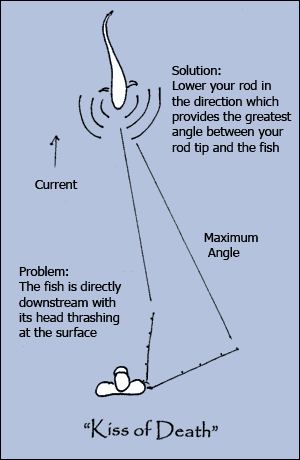
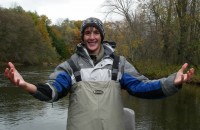
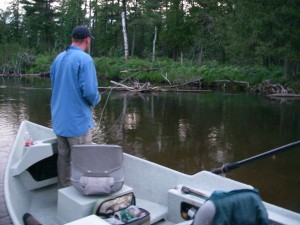
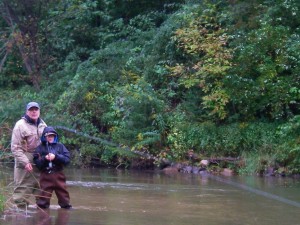
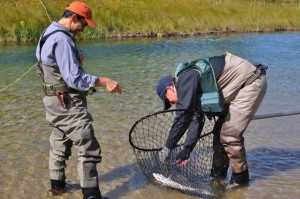
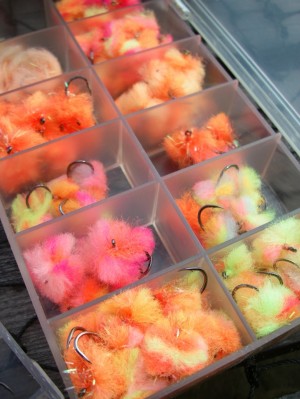
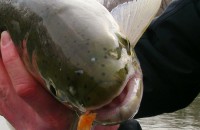
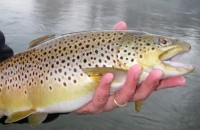
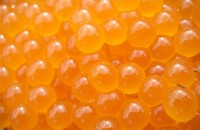
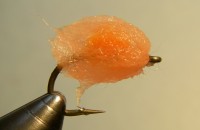
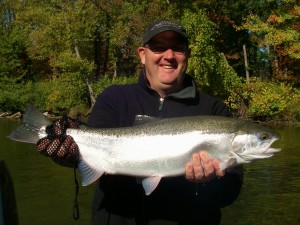
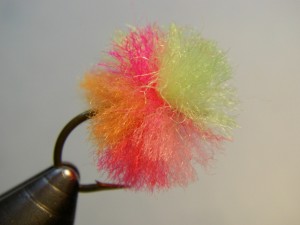
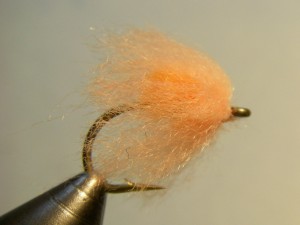
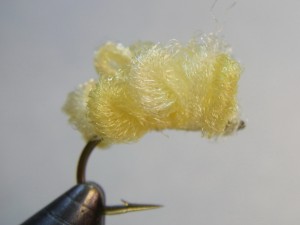
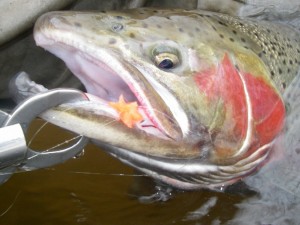
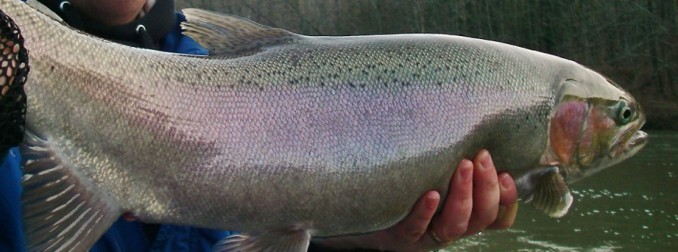
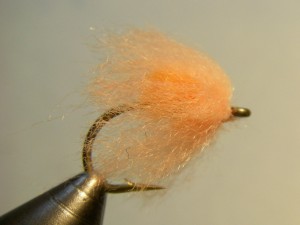
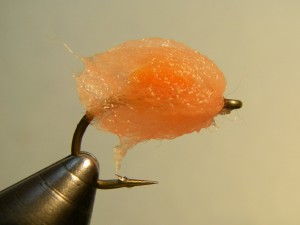
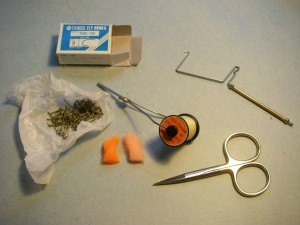
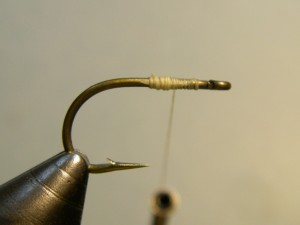 Step 1. Put hook in Vise and wrap a thread base from eye back to just above hook point.
Step 1. Put hook in Vise and wrap a thread base from eye back to just above hook point.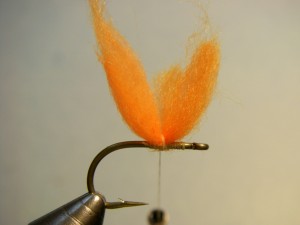 Step 2. Take a very small amount of yarn for the nucleus – aprox. the diameter of your whip
Step 2. Take a very small amount of yarn for the nucleus – aprox. the diameter of your whip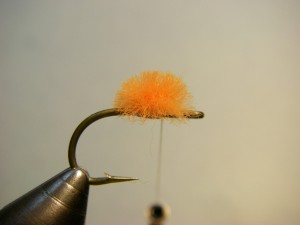 Step 3. Hold both ends of nucleus upward and trim very close to the hook shank – aprox. 1/8”.
Step 3. Hold both ends of nucleus upward and trim very close to the hook shank – aprox. 1/8”.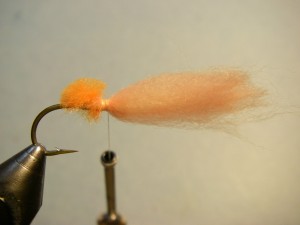 Step 4. Take 1 inch of veil yarn – the amount/thickness should be aprox.
Step 4. Take 1 inch of veil yarn – the amount/thickness should be aprox.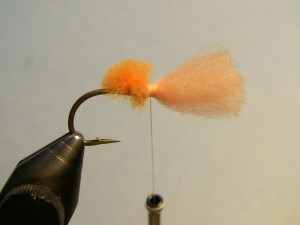 Step 5. Trim yarn so it is aprox. the length of the hook shank from the tie in point.
Step 5. Trim yarn so it is aprox. the length of the hook shank from the tie in point. Step 6. Carefully manipulate the veil material backwards – around the thread – evenly surrounding the nucleus.
Step 6. Carefully manipulate the veil material backwards – around the thread – evenly surrounding the nucleus.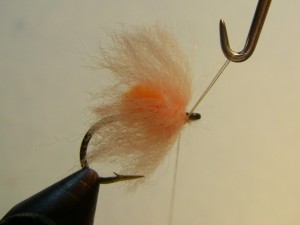 Step 7. Wrap thread a few times between the veil and the hook eye to make
Step 7. Wrap thread a few times between the veil and the hook eye to make